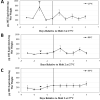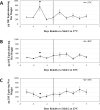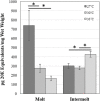Ecdysteroid responses to urban heat island conditions during development of the western black widow spider (Latrodectus hesperus)
- PMID: 35482802
- PMCID: PMC9049550
- DOI: 10.1371/journal.pone.0267398
Ecdysteroid responses to urban heat island conditions during development of the western black widow spider (Latrodectus hesperus)
Abstract
The steroid hormone 20-hydroxyecdysone (20E) controls molting in arthropods. The timing of 20E production, and subsequent developmental transitions, is influenced by a variety of environmental factors including nutrition, photoperiod, and temperature, which is particularly relevant in the face of climate change. Environmental changes, combined with rapid urbanization, and the increasing prevalence of urban heat islands (UHI) have contributed to an overall decrease in biodiversity making it critical to understand how organisms respond to elevating global temperatures. Some arthropods, such as the Western black widow spider, Latrodectus hesperus, appear to thrive under UHI conditions, but the physiological mechanism underlying their success has not been explored. Here we examine the relationship between hemolymph 20E titers and spiderling development under non-urban desert (27°C), intermediate (30°C), and urban (33°C) temperatures. We found that a presumptive molt-inducing 20E peak observed in spiders at non-urban desert temperatures was reduced and delayed at higher temperatures. Intermolt 20E titers were also significantly altered in spiders reared under UHI temperatures. Despite the apparent success of black widows in urban environments, we noted that, coincident with the effects on 20E, there were numerous negative effects of elevated temperatures on spiderling development. The differential effects of temperature on pre-molt and intermolt 20E titers suggest distinct hormonal mechanisms underlying the physiological, developmental, and behavioral response to heat, allowing spiders to better cope with urban environments.
Conflict of interest statement
The authors have declared that no competing interests exist.
Figures





Similar articles
-
The functional microclimate of an urban arthropod pest: Urban heat island temperatures in webs of the western black widow spider.J Therm Biol. 2024 Feb;120:103814. doi: 10.1016/j.jtherbio.2024.103814. Epub 2024 Feb 22. J Therm Biol. 2024. PMID: 38402729
-
Urban heat island conditions experienced by the Western black widow spider (Latrodectus hesperus): Extreme heat slows development but results in behavioral accommodations.PLoS One. 2019 Sep 6;14(9):e0220153. doi: 10.1371/journal.pone.0220153. eCollection 2019. PLoS One. 2019. PMID: 31490963 Free PMC article.
-
The prevalence of brown widow and black widow spiders (Araneae: Theridiidae) in urban southern California.J Med Entomol. 2012 Jul;49(4):947-51. doi: 10.1603/me11285. J Med Entomol. 2012. PMID: 22897057
-
Interactive effects of rising temperatures and urbanisation on birds across different climate zones: A mechanistic perspective.Glob Chang Biol. 2023 May;29(9):2399-2420. doi: 10.1111/gcb.16645. Epub 2023 Mar 13. Glob Chang Biol. 2023. PMID: 36911976 Free PMC article. Review.
-
The urban heat island effect, its causes, and mitigation, with reference to the thermal properties of asphalt concrete.J Environ Manage. 2017 Jul 15;197:522-538. doi: 10.1016/j.jenvman.2017.03.095. Epub 2017 Apr 14. J Environ Manage. 2017. PMID: 28412623 Review.
References
Publication types
MeSH terms
Substances
LinkOut - more resources
Full Text Sources

